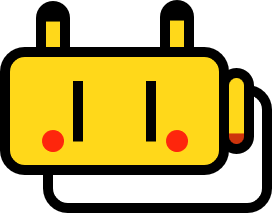Self-Inductance
Explanation1
In the situation shown in the figure above, if current $I_{1}$ flows through loop 1, magnetic field $\mathbf{B}_{1}$ will flow and the magnetic flux passing through loop 2 can be calculated as follows.
$$ \Phi_{2} = M_{21}I_{1} $$
At this point, $M_{21}$ is referred to as mutual inductance. Now, let’s say the current $I_{1}$ flowing through loop 1 changes over time. Then, the magnetic flux passing through loop 2 also changes, and according to Faraday’s law, the change in flux induces an electromotive force in loop 2.
$$ \mathcal{E}_{2}=-\dfrac{ d \Phi_{2}}{dt}=-M\dfrac {dI_{1}}{dt} $$
From this, we can discover the astonishing fact that whenever the current flowing through loop 1 changes, a current flows in loop 2, which is completely unconnected and separated. Thus, not only does a change in current in one wire loop induce electromotive force in a nearby wire loop, but it also generates electromotive force in the wire loop itself.
This principle is simpler than one might think. If the current flowing through a wire loop changes, naturally, the magnetic field created by the current changes. Since the magnetic field changes, there is a change in the magnetic flux passing through the loop. Therefore, by Faraday’s law, electromotive force is induced in the loop itself. Just like mutual inductance, the magnetic field and magnetic flux that arise due to the above effect are proportional to the current flowing through the wire loop.
$$ \Phi=LI $$
The proportionality constant $L$ is called self-inductance or simply inductance. Similar to mutual inductance $M$, it depends only on the geometric characteristics of the loop (size, shape). The electromotive force generated in the loop when the current changes follows Faraday’s law.
$$ \mathcal{E}=-L\dfrac{dI}{dt} $$
The unit of inductance is $[H]$ Henry. The value of inductance is always positive. The $-$ symbol attached to the above equation signifies that the electromotive force is generated in a direction that opposes the change in current (opposite to the change in current). In other words, the higher the inductance $L$, the more difficult it is to change the current. This is why it is also referred to as back emf. It can be thought of as analogous to mass in mechanics; the heavier the mass, the harder it is to change its current state of motion.
David J. Griffiths, 기초전자기학(Introduction to Electrodynamics, 김진승 역) (4th Edition1 2014), p327-348 ↩︎
